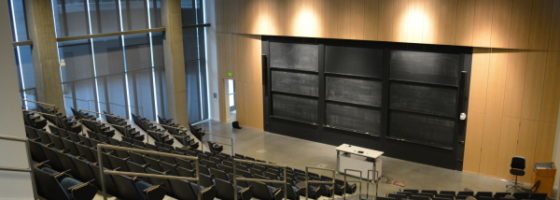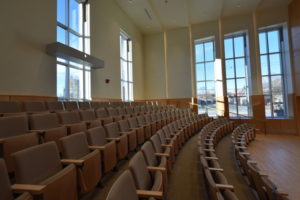Acoustic Classroom Design: Large Lecture Halls
Russ Cooper | May 1, 2017

The shape and layout requirements of a lecture hall are dictated by the acoustic and audio visual requirements. Getting acoustic and audio/video designers involved early in the design process is highly recommended. For example, concave curved surfaces are problematic because they improperly focus and unevenly distribute sound.
Designing Interactive Spaces
Though fixed-seating tiered lecture halls still dominate, changing trends suggest some designs are moving away from tradition. Instead, the design of lecture halls are moving towards more flexible interactive spaces, where fixed seating risers are replaced with loose seats and tables better suited for collaboration. Lecture halls are morphing into the flipped classroom, where students work together in groups to solve problems and listen to a lecture as homework. However, larger halls equate to larger volumes, which means acoustic consultants need to add additional sound absorption into the space to reduce the reverberation time. Unfortunately, adding absorption can have the negative impact of lowering the sound energy reaching the listener, making it hard to hear.
Improving Sound Quality
Acoustic consultants seek to balance a space to achieve ideal sound quality. A space with a long reverberation time is described as “live,” while a short reverberation time is described as “dead.” For lecture hall acoustic design, a controlled reverberation time between these two extremes increases the speech intelligibility, allowing for a better user experience. It also allows the teacher or lecturer to hear questions and feedback from the students.

Acoustic consultants use a combination of sound absorptive and diffusive materials to achieve this balance. Absorptive finishes, such as carpeting and fabric-wrapped panels, reduce the reverberation time while diffusion is achieved using commercially available three-dimensional reflective panels. The panels, which often look like sculptural art pieces, are designed to scatter sound energy and improve the quality of middle and high frequencies without absorbing too much sound.
Custom-tuning the sound in a room requires a delicate balancing act. While absorptive materials are necessary to reduce ringing sound quality, overuse can result in sound that is overly dead and flat. Similarly, while acoustic consultants want to encourage a certain amount of sound reflection to add clarity and richness, too many reflections will cause the sound quality and intelligibility to suffer.
Lecture Room Technology
Additionally, the presence of new technologies in lecture halls necessitates that acoustic and audio/video consultants work together to achieve optimum sound quality. This is especially prevalent in lecture halls used in educational, hospitality or corporate settings. These spaces use technology to provide unified communications —which is a combination of instant messaging, interactive whiteboards, and audio and video conferencing. All of this interconnection is pushing trends in lecture hall acoustic and audio/video design to keep up with technological advancements.
Since lecture halls are large rooms by nature, they typically require two key pieces of technology: a sound system and a large display for sharing content — either from a laptop, tablet or local computer. Lecture halls may also be equipped with lecture-capture technology, which allows content to be recorded or streamed live out of the room. Technology can also be used to stream content into the space, allowing for back-and-forth interactions.
As our classrooms and public spaces continue to be influenced by design trends like the flipped classroom and emerging technology, the need for high-quality lecture hall acoustic design, combined with effective audio/video design, is more important than ever. Acoustic and audio/video design specialists have the experience necessary to anticipate and solve communication or sound quality problems. Getting the right people involved early in the design process is crucially important — especially in larger rooms where understanding the human voice is the main objective.

Comments